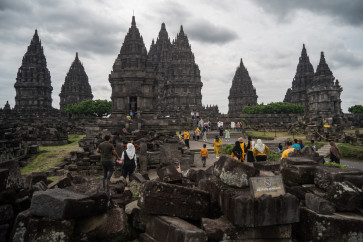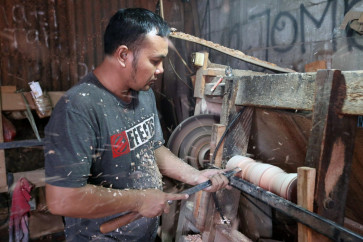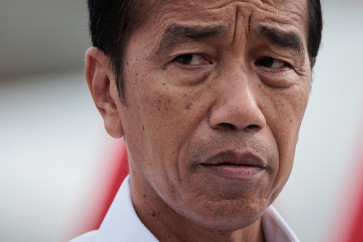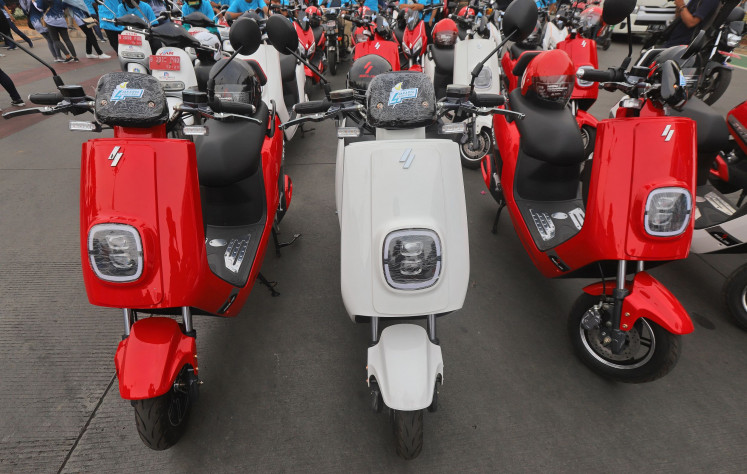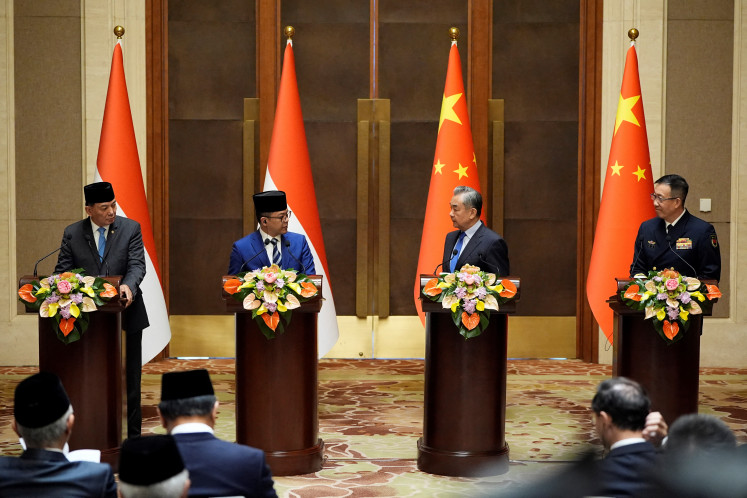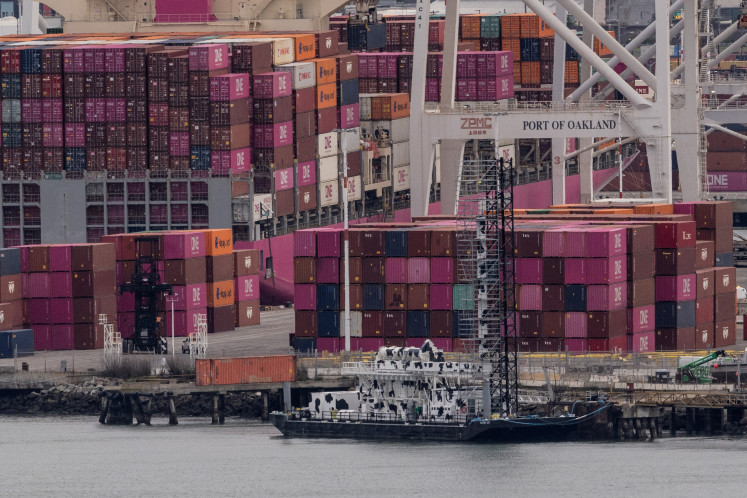Can we protect 'mega mendung' batik?
Recently, Indonesiaâs fashion industry and batik makers were appalled with the widely circulated photo of a mega mendung cloud-patterned blouse, sold online and offline by a leading European department store
Change text size
Gift Premium Articles
to Anyone

R
ecently, Indonesia's fashion industry and batik makers were appalled with the widely circulated photo of a mega mendung cloud-patterned blouse, sold online and offline by a leading European department store. The blouse in the traditional batik cloud pattern is said to be tagged 'limited edition Turkey'. It was one of those shocking déjà vu moments like that of a few years ago, when the renowned parang pattern was rumored to have been patented by a neighboring country.
Batik makers, particularly those in Cirebon, demanded that President Joko 'Jokowi' Widodo and the Trade Ministry stop the claim made by Turkey. Others urged foreign designers and department stores to acknowledge the origin of batik displayed in their collections.
The people of Cirebon, a town on the northern coast of Java, view the mega mendung pattern to have been founded by their prince centuries ago. However, scholars say the ancient pattern is an example of cultural assimilation between the Chinese and Indonesians, as the cloud motif is largely found in historical Chinese cultural expression. This motif, together with the dragon, once adorned not just the robes of Chinese emperors but also their palaces.
Yet dwelling on the origins of traditional textile leads to an endless discussion. As all leading figures in batik agree, the most important aspect of batik is the highest quality of the craftsmanship, in which no other country than Indonesia has excelled.
While it is heartening to see how fellow Indonesians are deeply concerned about our ownership of traditional batik patterns, the misconception, if not misunderstanding, around the issue is profound.
In Indonesia, batik is an object of protection, based on the 2014 copyright law ' it is not protected by patent. The duration of protection, in accordance with the economic rights principle, is valid throughout the lifetime of the batik creator and continues for 70 years after the death of the creator.
The law states that eligibility for protection is that a contemporary batik pattern is innovative, current and non-traditional. The raison d'être for this protection is its fine art value, based upon its image, ornamentation and color composition.
Violators, including those reproducing batik patterns in any form without a permit and distributing the pattern or its copies without a permit, face up to four years' imprisonment and/or a fine of up to Rp 1 billion (US$80,192) (Article 113 clause 3).
Hence, the 2014 law provides legal clarity for contemporary batik patterns. Is such clarity also rendered upon mega mendung, parang, kawung and other centuries-old patterns?
The law apparently does not govern these patterns in an explicit manner. Article 38 clause 1 only states that Indonesia's traditional cultural expression (TCE) is held by the state. Article 38 clause 2 further states that the state is obliged to make an inventory and to safeguard and maintain all its TCE. Detailed provisions regarding protection of TCE will be arranged through a governmental regulation (article 38).
In line with Article 38, the most effective way to provide protection to mega mendung, parang, kawung and other traditional patterns is to list all these patterns as objects of TCE. So far I have not found an official list that can be publicly accessed, either written or online, of all the traditional batik patterns.
Some Indonesians learned about batik patterns from their parents, others from scholarly publications in books, journals, the Internet, etc. ' with large discrepancies. One journal, states mega mendung was created by a native of Cirebon without any foreign influence, while others share different opinions.
In 1997, the World Batik Conference in Yogyakarta highlighted that information collection and documentation were vital to the collective history of batik, as well as to its continued development. The declaration of the 1997 conference underlined the need to create a batik database to serve as a major educational, cultural and industrial resource to Indonesia and the world.
The declaration was perhaps forsaken, if not forgotten. Now, this problem has arisen again, or at least become more alarming, because there is no centralized and unified source run by Indonesia's designated-authority. No official, just-a-click-away, online source where Indonesians and foreigners can simply find all the traditional batik patterns. The lack of an official source leads to a lack of proof.
Even a lay person would understand that when there is no written evidence to prove Indonesia's ownership of mega mendung, how could we seek acknowledgment from a foreign party?
A digitalized inventory of traditional patterns, such as a database, would not be the ultimate remedy to batik protection. But it is a condition sine qua non for batik to be protected as a traditional cultural expression. The previous 2002 Copyright Law implied that objects of such expression would be further defined in a government regulation. Yet no regulation had ever been enacted by the time the previous law was replaced. This law should not experience a similar fate.
The Law and Human Rights Ministry through its directorate general for Intellectual Property Rights, has conducted several successful dissemination programs on the 2014 Copyright Law to academics, musicians and performing artists, among its stakeholders.
Perhaps it is time for the next outreach programs to invite notable stakeholders in the batik industry, including artisans, designers and entrepreneurs from their producing areas, such as Cirebon and Pekalongan in Central Java, Lasem in East Java, etc.
This is pertinent to keep batik makers well informed about the type of protection available for their creations.
This is timely and in line with Jokowi's call to emphasize economic and cultural diplomacy, of which batik is a vivid example. But to do so, we need to wisely arm ourselves with the right tools
Pointing fingers, temporary emotional outbursts and unfounded accusations are never a good way to embark. Rather, it is urgent that we identify the follow-up actions.
Mega mendung and other traditional patterns cannot be seen as mere patterns of Indonesia's traditional cloths, or objects of desire in the fashion world. They must be remembered first and foremost as inherent parts of our traditional cultural expression, which shaped Indonesia's illustrious civilization.
So can we protect mega mendung batik? Yes, we can! It would be difficult and probably costly to establish a digitalized inventory.
But the longer the delay, the larger the possibility that rows over batik will erupt again.
The writer is pursuing his post-graduate degree at the school of law, University of Sydney, and previously served at the Foreign Ministry's directorate for economic and socio-cultural treaties in Jakarta. He was posted, among others, to the Indonesian Mission to the UN and the World Trade Organization in Geneva. The views expressed are personal.

